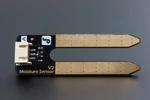








Gravity: Analog Soil Moisture Sensor for Arduino & Raspberry Pi
- $2.50 2+ items
- $2.30 5+ items
- $2.10 10+ items
Introduction
The Gravity Analog Soil Moisture Sensor offers resistive soil moisture detection with 0-4.2V analog output, compatible with Arduino and Raspberry Pi. Designed for short-term indoor plant monitoring and educational projects. Perfect for smart home IoT projects and basic electronics courses, this 3.3V/5V sensor features plug-and-play integration and cost-effective soil moisture analysis.
The new soil moisture sensor uses Immersion Gold which protects the nickel from oxidation. Electroless nickel immersion gold (ENIG) has several advantages over more conventional (and more cost effective) surface platings such as HASL (solder), including excellent surface planarity (particularly helpful for PCB's with large BGA packages), good oxidation resistance, and usability for untreated contact surfaces such as membrane switches and contact points.
This soil moisture Arduino sensor uses the two probes to pass current through the soil, and then it reads that resistance to get the moisture level. More water makes the soil conduct electricity more easily (less resistance), while dry soil conducts electricity poorly (more resistance).
This sensor will be helpful in reminding you to water your indoor plants or monitor the soil moisture in your garden.
To ease the difficult of using this sensor, a Gravity Interface is adapted to allow plug & play. The Arduino IO expansion shield is the best match for this sound senor connecting to your Arduino. As this sensor can work at 3.3V, makes it compatible with Raspberry Pi, Intel Edison, joule, and curie.
Note:
For more detailed insights on selecting the most suitable sensor, refer to the guide on [How to Select the Best Soil Moisture Sensors for Agriculture and Research Lab].
If you are going to place the sensor to very humid soil, that would make it very easy to get the sensor surface erosion within several days, hence we suggest to use this one Analog Capacitive Soil Moisture Sensor- Corrosion Resistant instead.
Specification
- Power supply: 3.3v or 5v
- Output voltage signal: 0~4.2v
- Current: 35mA
- Pin definition:
- Analog output (Blue wire)
- GND (Black wire)
- Power (Red wire)
- Size: 60x20x5mm (2.36x0.79x0.2")
- Surface finish:Immersion Gold
Projects
Project 1. Brian Kelley watering project
Project 2. IOT Plant Moisture Notifier
Get a text or call if your plant is getting too dry, along with a nice LCD display giving information regarding your plant's health.
Hardware Components:
Documents
Shipping List
- Moisture sensor x1
- Analog Sensor Cable x1
Resource

Projects How to Create a Solar-Powered Balcony Plant Soil Moisture Monitoring System with ESP32-C6

Projects SCI Plant Monitor: The Smart Way to Track and Analyze Your Plant's Data for Growth













